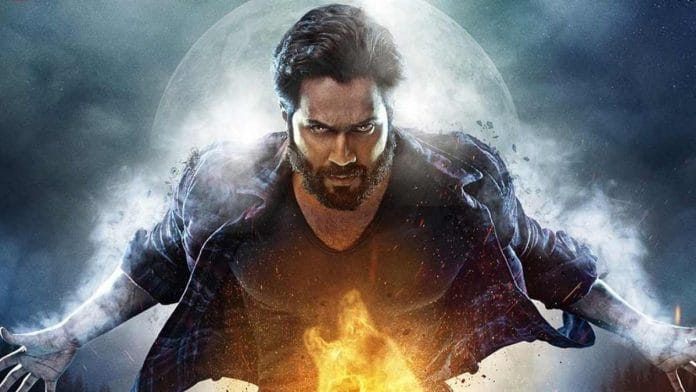A 156-minute visual achievement, Amar Kaushik’s Bhediya is a treat for horror-comedy enthusiasts. Kaushik, who created the brilliant and successful Stree in 2018, has not only mastered a complex genre but also given stiff competition to some of this year’s best horror comedies, such as Kartik Aaryan’s Bhool Bhulaiyaa 2 and Katrina Kaif’s Phone Bhoot. From The Jungle Book to The Boy Who Cried Wolf, Bhediya makes good use of pop culture elements to give you a Twilight-like experience, albeit with a generous sprinkling of humour.
A road construction contractor, Bhaskar (Varun Dhawan) goes to Arunachal Pradesh with his cousin Janardhan (Abhishek Banerjee) to build a highway through the dense jungles of Ziro. He meets a local friend Jomin (Paalin Kabak) and starts his mission to cut Ziro’s forests for ‘development.’ But he is opposed by village elders and made aware of the legend of ‘Vishanu’, a shape-shifting wolf who protects the forest. A series of unexpected deaths take place soon after Bhaskar is bitten by one, and what happens next forms the story of Bhediya.
Bhaskar’s transformation from human to werewolf is convincing and visually impactful, while Kaushik’s strategy of weaving jump scares with funny moments—an art that he perfected in Stree—is top-notch.
However, one of the film’s main heroes is the breathtaking visual world created by cinematographer Jishnu Bhattacharjee and writer Niren Bhatt. It elevates the enigmatic world of werewolf transformation and comes alive in the spectacular jungles of Ziro, against the backdrop of a menacing full moon. The last movie that captured the jungle’s mood and ambience this way was perhaps Kiccha Sudeep’s Vikrant Rona (2022). But there, it was custom-made. Bhediya relies on a mix of real locations and artificial effects to transport you to the chilling-yet-magical forests of Ziro. Prabhas-starrer Adipurush should take a leaf out of Bhattacharjee and Kaushik’s playbook because Bhediya has some of the most impeccable visual effects this year.
The best part about Bhediya, though, is its use of stereotypes to dismantle stereotypes against people from the Northeast. Kaushik also makes great use of local beliefs and folklore to sensitise people on the pressing issues of environmental degradation and ecological imbalance—making a valid point without resorting to preachy tactics.
Also read: Sudhir Mishra’s Tanaav on SonyLIV is a hollow take on Kashmir. The tension is missing
Formidable cast, crackling chemistry
Varun Dhawan is at his best in this film. In a commendable feat, Kaushik makes the actor shed his typical Bollywood macho image to fit the role of a boyish, capitalist go-getter who wants his social and financial status to shift from Delhi’s “Jamunapar to Greater Kailash.” From caring only about green cash and not greenery to finally realising his role in the chaos around him, Bhaskar’s journey of self-realisation is portrayed well by the actor.
Kriti Sanon as Dr Anika, the veterinarian who treats Bhaskar’s werewolf bite, delivers an earnest and impactful performance despite less screen time. Deepak Dobriyal and Abhishek Banerjee form an excellent supporting cast as their comic timing keeps the boat sailing. Abhishek Banerjee is especially good as Bhaskar’s good-for-nothing cousin and shows us that he is a force to reckon with.
Paalin Kabak as Jomin provides some of the film’s more insightful moments by schooling Bhaskar and his cousin on their inherent racial bias—‘gyan’ shrouded in smart, crisp dialogues and infused with comedy. But the crackling chemistry between him, Dhawan and Banerjee is what keeps you hooked to the movie. It is also interesting to see veteran theatre actor Baharul Islam play a small role as a corrupt engineer ready to sacrifice forests while spouting pearls of wisdom on the importance of a sustainable lifestyle.
Also read: Uunchai is Barjatya’s coming-of-age moment. He finally moved on from his 1990s Prem obsession
Getting Northeast right
The use of multiple regional actors and local references—such as swear words in Assamese, a language spoken by many in the state, and the practice of carrying a dao (machete)—deserves kudos for portraying regional realities without resorting to exoticisation. The concept of medicine man or Ojha, an integral part of the culture of Arunachal’s Apatani tribe, is also brought in to emphasise the importance of legends and faith healing in the region.
Kaushik was born In Medo, Arunachal Pradesh and his father was an official in the state’s forest department. In fact, Kaushik’s first solo directorial venture was a short film called Aaba, also set in Ziro. For Bhediya, he returns to his roots and how. This is what probably renders sensitivity to the film—an element missing from most mainstream representations of the Northeast.
Views are personal.
(Edited by Zoya Bhatti)






